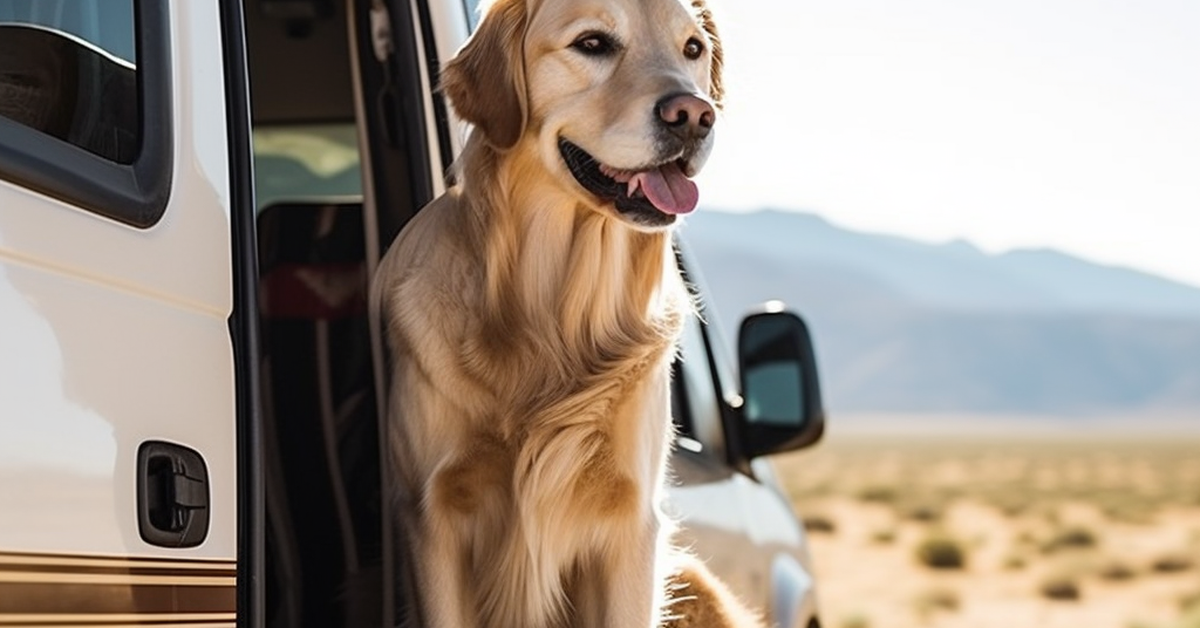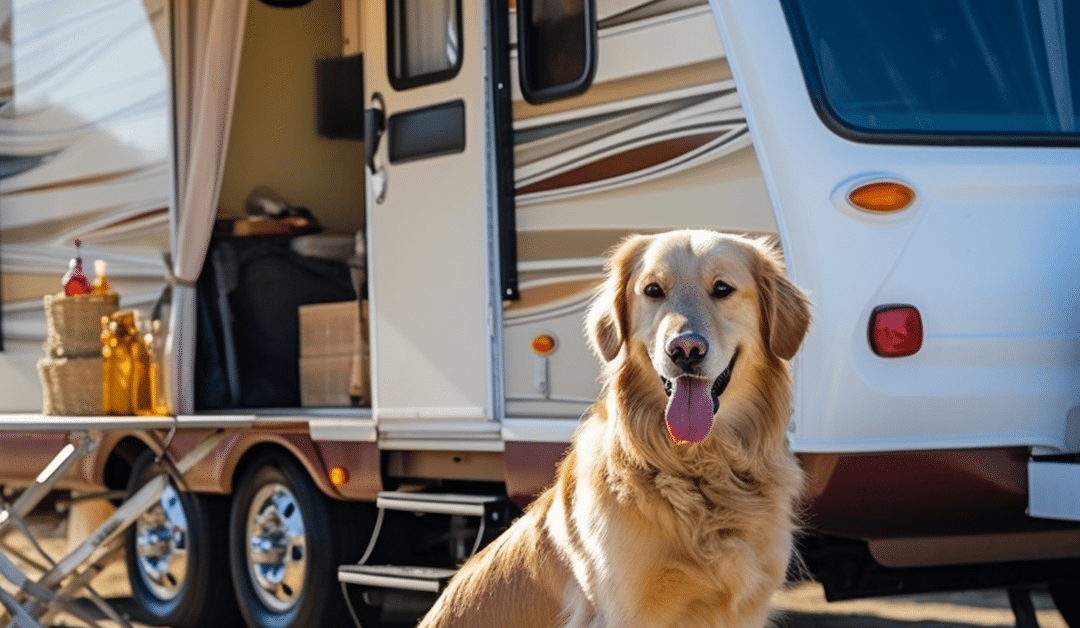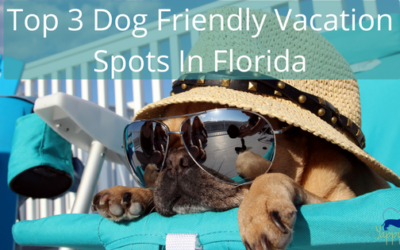RV Safety Tips for Traveling With Dogs: Must-Know Strategies

Hitting the road in an RV with your dog by your side? Safety comes first. Ensuring a paw-sitive journey for your four-legged companion requires careful thought and planning. This guide is chock-full of strategies to keep your pup safe and snuggly as you roll to your next adventure. We’ll cover securing your pet, managing their comfort, and more. It’s all about creating memories without the worry.
RV trips mean freedom, but with pets on board, it’s not just “where to next?” You’ve got to think of their needs too. Picture this: open windows, wagging tails, and new scents on the breeze. But wait! What about sudden stops or sharp turns? What if Spot gets anxious or, worse, sick? Don’t fret, we’ve got the lowdown on all that and more. We’re not just talking leashes and water bowls; we’re diving into the nitty-gritty of canine travel safety.
With the groundwork laid, let’s steer towards our next chapter: Pre-Travel Preparation and Checklist. Here, you’ll find a treasure trove of tips to ensure your furry friend is as road-ready as you are. From the essential gear to the comfort must-haves, we’ve got your checklist covered. So buckle up, and let’s get your pooch prepped for the long haul!
Pre-Travel Preparation and Checklist

Are you gearing up for an RV adventure with your furry best friend? Safety and comfort are key for a pawsome trip! Here’s a tail-wagging checklist to ensure your dog’s well-being as you hit the road.
- Craft a detailed checklist for your dog’s travel needs
- Check that your RV is a safe haven for your pooch
- Pack essentials like chow, H2O, and a doggie first-aid kit
Pre-Travel Checklist:
- Vet Records: Bring vaccination proof and health records.
- Medications: Pack any regular or emergency meds.
- Identification: Update tags and microchip info.
RV Pet-Proofing:
- Secure trash cans and remove toxic plants
- Install a pet gate for safety
- Check window screens for integrity
Essential Supplies:
| Item | Quantity | Purpose |
|---|---|---|
| Food | Enough for the trip | Keep that tail wagging with regular meals |
| Water | Ample supply | Hydration is key |
| Toys | A few favorites | For comfort and playtime |
| Leash & Harness | 1 each | For secure pit-stops |
| Bedding | 1 cozy setup | For sweet dreams in a new place |
Quick Tips:
- Long walks before the trip can calm your dog
- Pack a picture in case your buddy goes on an unexpected adventure
Remember, your dog relies on you for their safety. A well-thought-out plan can make the journey enjoyable for you both. It’s wise to check your pet’s comfort frequently and take regular breaks for stretching those four legs.
When these preparations are ticked off your list, you can rev up the RV, knowing you’re on track for a smooth ride. Next, we’ll think about the travel space itself, ensuring it’s snug and secure for your companion as the wheels roll on.
Secure and Comfortable Travel Space
Every dog-loving RV owner knows the thrill of hitting the open road with their furry companion. But before you rev up the engine, safety’s got to be your number one priority. It’s all about making sure your pooch has a secure spot to chill while you’re cruising.
- Finding the perfect crate or harness: You’ll want to snag a travel crate or harness that’s just the right fit for your dog.
- Getting your dog used to their travel zone: A few trial runs can help your dog get comfy with their new mobile hangout.
- Setting up a cozy and secure area: With some clever arranging, you can make a travel space that’s safe and snug for your pet.
Picture this: you’re all set to embark on an adventure in your RV, and your canine buddy is tagging along. But wait! Is your pooch prepped for a safe journey? Let’s break it down.
Choosing the right travel crate or harness for your dog: Picking a solid crate or harness is like choosing the best seatbelt for yourself. It’s gotta be snug, but not too tight. And roomy enough so they can stretch a bit. Your dog’s size and the RV’s layout are key factors here. For a small pupper, a crate might be best. For a bigger furball, a harness that attaches to the seatbelt could be the way to go.
Tips for acclimating your dog to their travel space: Don’t just throw your dog into the RV and expect them to be cool with it. Start by letting them chill in their crate or harness inside the house. Once they’re giving off those relaxed vibes, move the setup to the RV, parked of course. Give them treats and their favorite toy to make it feel like home.
Arranging a space that is both secure and comfortable during travel: Your dog’s travel spot should be away from any loose items that could go flying if you have to hit the brakes. Make sure there’s no direct sun beaming down on them, and if possible, right by an air vent for some comfy airflow. Cozy bedding is a must, and if there’s room for a favorite toy, even better.
Now let’s get into the nitty-gritty with a list of essentials:
- Secure the crate or harness to prevent it from moving around
- Test different spots in the RV for the best fit
- Regular checks to ensure everything’s holding up during the trip
And remember, just like us humans, dogs need their own space to stretch and relax.
| Item | Description | Importance |
|---|---|---|
| Travel Crate | A safe enclosure for your dog to stay in while moving | High |
| Safety Harness | Secures your dog to a seatbelt for stability | High |
| Bedding | Comfortable material for your dog to lie on | Medium |
| Favorite Toy | An item to keep your dog occupied and calm | Low |
As you’re prepping for pit stops and enjoying the scenic views, it’s key to keep an eye on your best bud’s needs. They’ll need regular breaks, just like you, to stretch their legs and take care of business. It’s all about balancing the excitement of exploring new places with making sure your canine companion is safe and sound.
For more tips on traveling with your dog, check out this handy guide. And for a personal touch, I’ve found that setting up my golden retriever’s travel crate right by the window, with his favorite chew toy and a cozy blanket, keeps him calm and content on our long drives.
Remember, the goal is to have a blast and create memories with your four-legged pal while keeping them out of harm’s way. Cool? Cool. Let’s hit the road and make it a trip to remember, full of tail wags and happy barks.
Regular Breaks and Exercise

Hit the road with your pup in an RV? Nice choice! Dogs love adventures as much as humans. But remember, long drives can be a real drag for dogs. So, let’s break down how to keep tails wagging during RV travels.
Planning for Frequent Rest Stops for Bathroom Breaks and Exercise
Dogs need breaks, just like us. Plan to stop every few hours for potty breaks and leg stretching. You’ll thank yourself, and your dog will too. Map out pet-friendly rest stops before you head out. That way, you avoid guesswork on the go.
Keeping Your Dog Entertained and Active During Breaks
Bored dogs can get into mischief. Keep their minds busy with a variety of toys and activities during stops. Think fetch, tug-of-war, or even a quick obedience training session. Fun and games keep them sharp and ready to roll when it’s time to hit the road again.
| Break Time | Activity Ideas | Benefits |
|---|---|---|
| 15-minute stop | Quick walk and fetch game | Physical exercise |
| 30-minute stop | Tug-of-war and training | Mental stimulation |
Recognizing Signs of Travel Stress and How to Alleviate It
Dogs might stress out on long trips. Watch for signs like whining, pacing, or excessive licking. Calm them down with familiar items like their favorite blanket or toy. Comfort from home can make all the difference.
Here are a few more tips to make the journey smoother:
- Pack their favorite snacks. Rewards go a long way.
- Maintain routine. Dogs love predictability.
- Hydrate! Keep water handy at all times.
As we wrap up, it’s crucial to keep your dog’s comfort in mind for the whole trip. Think about how you’d feel stuck in a car all day. Not fun, right? Apply the same empathy to your furry copilot. Next up, let’s consider how to ensure their well-being continues with proper temperature and fresh air, especially on those hot summer days or chilly evenings. Keeping the air moving and the climate controlled will make sure your adventure buddy stays comfortable, no matter where the road takes you.
For additional insights on safe travels with your canine companion, check out resources provided by RVing experts. And remember, the joy of the journey is in sharing it with those we love, two legs or four.
RV Safety Tips for Traveling With Dogs: Must-Know Strategies

Traveling in an RV with your furry pal can be a blast! But it’s vital to keep their safety a priority, especially when it comes to temperature and fresh air. Here’s what you need to know to make sure your dog stays cozy and chirpy on the road.
Managing RV Temperature for Your Dog’s Safety
RVs can turn into ovens or freezers, depending on the weather. Always check inside temps and keep them in the Goldilocks zone for dogs. In scorching heat, park in the shade and use air conditioning. When it’s cold, insulation and RV heaters are your friends.
Ensuring Adequate Ventilation and Air Flow
Stuffy RV? No good for pups. Crack open those windows or set up fans. Airflow keeps the space fresh.
Monitoring Your Dog for Signs of Overheating or Cold Stress
Keep an eagle eye on your doggo. Panting like crazy or shivering? Not cool. Adjust the RV’s climate to help them out.
Top Tips for a Tail-Wagging Journey
– Park in the shade during sunny days
– Use a temperature monitor to keep track
– Snuggle-safe blankets for chilly nights
Stats to Bark About
– 72°F: Ideal indoor temp for most dogs
– 5 minutes: How fast a car (or RV) can heat up in the sun
Pre-Trip Checklist
1. Test RV climate controls
2. Pack doggy blankets or cooling mats
3. Grab a temperature monitor
Temperature Control Table
| RV Feature | Use for Dogs | Tips |
|---|---|---|
| Air Con | Cooling down | Set to a dog-friendly temperature |
| Heater | Warming up | Keep it cozy, not hot |
| Fans | Air flow | Point away from dogs to avoid drafts |
Remember, the goal here is to keep tails wagging. For more insightful advice, check out how to travel safely in an RV with a dog.
Now, as we wrap up our chat on keeping your canine companion comfy in your RV, let’s think about the next step in your travel prep. Picture you and your pup, all set for adventure, but before you hit the road, you’ll want to ensure they’re easily identifiable, just in case they decide to go on an unplanned solo expedition. So, gear up for smooth sailing, and let’s make every trip with your four-legged friend a memorable one!
Pet Identification and Documentation

When you’re hitting the open road with your furry friend in an RV, safety is paramount. You’ll want to make sure your dog can be identified swiftly if they go missing or an emergency arises. Here’s how:
- Update your dog’s microchip with the latest contact details. It’s a surefire way to reunite with your pet if they wander off.
- Tags are a must. Ensure they’re current and readable.
- Carry your dog’s health records and vaccination proof. You never know when you’ll need them.
- Preparing for the unexpected is smart. Pack a pet first aid kit and keep your vet’s contact info handy.
Documentation Checklist
| Item | Description | Notes |
|---|---|---|
| Microchip Registration | Confirm current details are on file | Contact microchip company |
| Tags | Attach to collar with up-to-date information | Include mobile number |
| Vaccination Records | Proof of rabies and other shots | Required at some campgrounds |
| Health Documentation | Recent vet visits, any medications | Important for emergency care |
| Pet First Aid Kit | Bandages, antiseptics, tweezers, etc. | Customize based on pet’s needs |
| Vet Contact Information | Phone number and address | Keep both local and home vet info |
These steps are just part of ensuring a smooth RV adventure with your canine companion. As we gear up for the journey, let’s not forget about their daily necessities. Picture your dog’s day-to-day routine. Now think about how you’ll manage that in the confines of an RV. You’ll need to consider their meals, hydration, and any medication they might be on. Ensuring you have enough of their usual food to last the trip is crucial, as changing their diet suddenly could lead to digestive issues. It’s also vital to maintain their regular feeding schedule to give them a sense of stability.
Water is another concern. Always have plenty of fresh water available, especially if you’re traveling to areas with uncertain water quality. And finally, if your dog is on medication, double-check you have enough to last the trip, plus a little extra in case of delays.
Adjusting to life on the move can be as exhilarating for your pet as it is for you. With careful planning and a dash of foresight, you and your dog can enjoy the freedom of the road without worry. For more insights on RV travel with dogs, have a look at this resourceful guide on how to travel safely in an RV with a dog.
Remember, the road ahead is not just a path to your next adventure—it’s a shared journey with your faithful companion. By taking the right precautions, you can ensure that every mile is as safe as it is enjoyable.
Managing Food, Water, and Medications

Hitting the road in an RV with your dog can be an adventure filled with fun and bonding. Yet, it’s essential to keep your furry friend well-fed, hydrated, and healthy during the journey. Here’s how you can manage your dog’s needs effectively.
- Storing food and water is a task to handle with care. Use airtight containers to keep your dog’s food fresh and prevent spoilage. For water, consider a spill-proof bowl or a special pet water bottle designed for travel. This ensures your dog stays hydrated without the mess.
- Follow a regular feeding and medication schedule. Dogs thrive on routine. Aim to feed your dog and administer any medications at the same times you would at home. This consistency helps prevent digestive issues and keeps your dog at ease.
- Plan ahead to avoid travel-related digestive issues. A sudden change in diet can upset your dog’s stomach, so bring enough of their regular food for the entire trip. Also, pack any medications they need and familiarize yourself with the location of veterinarians along your route.
Here’s a quick table to help you plan:
| Item | Tip |
|---|---|
| Food | Use airtight containers for freshness |
| Water | Invest in a spill-proof bowl |
| Medication | Keep to a strict schedule |
| Regular Feeding Times | Mimic home routine as much as possible |
| Digestive Health | Avoid new foods, plan for consistency |
As you wrap up the food, water, and medication planning, remember that each step you take contributes to a stress-free trip for both you and your dog. Next up, consider the safety protocols for different scenarios you might encounter on the road. Whether it’s a flat tire or an unexpected storm, being prepared ensures you and your dog can handle any situation with calm and ease.
Safety Protocols for Different Scenarios

Embarking on an adventure with your canine companion in an RV is a fantastic way to explore and bond. Yet, it’s vital to keep safety top of mind. Here are essential strategies for keeping your dog safe on the road.
Preparing for emergencies like accidents or natural disasters is key. Pack a pet first-aid kit. Include bandages, antiseptic wipes, and your dog’s medical records. Know the nearest vet in each area you visit.
Wildlife encounters can be unpredictable. Keep your dog on a leash during hikes. Store food securely to avoid attracting animals to your campsite. If you meet another dog, ensure both pets are calm before allowing them to meet.
Routine is comforting for dogs. Practice a specific command for entering and exiting the RV. This prevents your dog from dashing out unexpectedly, which could be dangerous.
Let’s break it down further:
- Emergency Kit: Keep it accessible. Include a flashlight and extra batteries, too.
- Local Vets: Research before you travel. Have their contact info handy.
- Leash: It should be strong and comfortable for your dog.
Tips for RV Travel With Dogs
- Secure Your Dog While Driving: Use a crash-tested crate or harness.
- Regular Stops: Take breaks for exercise and bathroom needs.
- Climate Control: Never leave your dog in the RV alone without proper ventilation and temperature control.
- Safe Spaces: Create a cozy, secure spot in the RV where your dog can retreat.
Here’s a simple table to help you remember these tips:
| RV Safety Tip | Description |
|---|---|
| Secure Travel | Use a crate or harness for your dog’s safety in transit. |
| Break Time | Regular stops for exercise and potty breaks. |
| Temperature | Monitor the RV’s inside temperature. |
| Cozy Corner | A designated area for your dog to feel safe. |
Remember, these strategies will help ensure that you and your furry friend enjoy a stress-free journey together. As we wrap up, think about the joy that comes from watching your dog’s tail wag in a new place. Imagine the peace of mind you’ll have, knowing you’ve taken steps to keep them safe. Now, let’s look forward to creating those wonderful travel memories.
For more insightful tips on traveling with your best pal, consider checking out resources on pet-friendly RVing. And if you’re curious about how often you should feed your dog while on the road, Yappy Life has an excellent guide to keep your dog’s tummy as happy as their heart on the journey ahead.
Conclusion
Hitting the road with your pup in an RV brings heaps of fun and a unique chance to bond. You’ve just gotta make sure you’ve got the safety part down. We talked about everything from securing your doggo to keeping their tails wagging with familiar toys. Now, remember, the goal isn’t just to reach a place. It’s about making those moments count with your furry co-pilot. So, gear up, follow these savvy tips, and you’re good to hit the road.
Key Takeaway
The big thing to remember is that preparing your RV for your dog means a smooth ride for everyone. It’s all about safety and those little comforts. Take these tips, tuck them in your pocket, and use ’em. Your dog will thank you with tail wags, and you’ll thank yourself when you see them all chill and happy. And hey, while you’re living the Yappy Life, check out our shop for some neat gear for both of you. Keep those tails wagging, and let’s make every trip a blast, safe and sound.
Got thoughts or a story about RVing with your dog? Shoot us a message or drop a comment. We’re all ears. Let’s share the good vibes and spread the word about safe travels with our four-legged family. And if you’re looking to spoil your pup with some fresh gear, our Yappy Life shop is just a click away. Go on, grab something that says “I love my dog and I love our adventures together!”
Frequently Asked Questions about RV Safety Tips for Traveling with Dogs
What are the best ways to secure my dog during RV travel?
To ensure your dog’s safety while traveling in an RV, use a crash-tested pet harness or a travel crate that’s secured to the vehicle. This prevents your dog from being tossed around in case of sudden stops or an accident. Make sure the harness or crate is appropriately sized and comfortable for your pet.
How often should I stop for breaks when traveling with my dog?
It’s recommended to stop every 2-3 hours to allow your dog to stretch, exercise, and relieve themselves. This helps prevent restlessness and discomfort. It’s also an opportunity for you to take a break and refresh.
What should I include in a pet emergency kit for RV trips?
Your pet emergency kit should include your dog’s medical records, medications, a first-aid kit, extra food, water, a bowl, a leash, waste bags, and any special care instructions. It’s also wise to have a recent photo of your dog in case they get lost.
How do I keep my dog cool in the RV during hot weather?
To keep your dog cool, always park in shaded areas, use air conditioning or fans, provide plenty of fresh water, and never leave your dog unattended in the RV. Overheating can happen quickly and can be fatal, so it’s crucial to monitor the temperature inside your RV.
What is the best way to acclimate my dog to RV travel?
Start by introducing your dog to the RV while it’s stationary. Let them explore and get comfortable with the space. Take short trips to get them used to the movement and sounds. Gradually increase the length of the trips as your dog becomes more comfortable.
How can I keep my dog from getting anxious during RV trips?
Maintain a calm and routine environment. Bring along their favorite toys, bedding, and other familiar items. Consider using calming pheromone sprays or consult your veterinarian about anti-anxiety medication if your dog is prone to severe anxiety.
What should I do if my dog gets car sick while traveling in the RV?
If your dog is prone to motion sickness, feed them a light meal a few hours before travel and limit water intake to reduce the risk. Consult your vet for motion sickness medication or remedies. Stop the RV and take a break if your dog shows signs of sickness.
Is it necessary to use a pet seatbelt in an RV?
Yes, it’s important to use a pet seatbelt or a secured travel crate while the RV is in motion. This keeps your dog safe and prevents them from distracting the driver or becoming a projectile in the event of a sudden stop or accident.
How can I ensure my dog’s safety when RV camping?
Always supervise your dog while camping, keep them on a leash or in a secure area, and be aware of local wildlife that could pose a threat. Ensure your dog is up to date with vaccinations and has proper identification, such as a collar with tags and a microchip.
What steps should I take if my dog gets lost during an RV trip?
Immediately search the surrounding area and notify campground staff or local authorities. Have a recent photo and description of your dog to share. Also, make sure your dog’s microchip information is up to date so that shelters or vets can contact you if your dog is found.



Recent Comments